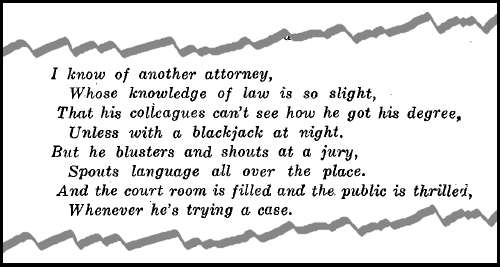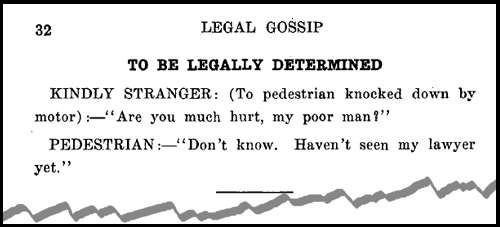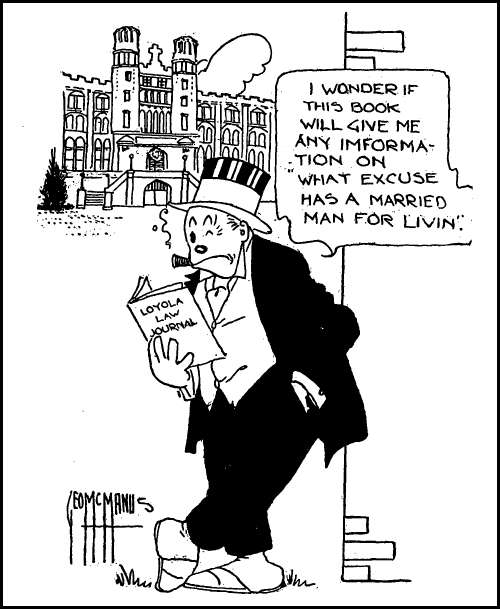Law reviews were very different eighty years ago. The scholarly articles in the early Loyola Law Journal were shorter - eight to ten pages seems to be average - and footnotes are rare. But what is really different about older law reviews like the Journal is what else they published. The Loyola Law Journal and other schools’ early law reviews seemed to have served a dual purpose as both a forum for serious scholarship and a place for general law school news and, surprisingly, funny poems and other humorous items. And these other miscellanea can be an interesting window into the history of both legal education and the legal profession.
A typical example of a humorous poem, “Tale of Two Lawyers”, is a good piece of doggerel that holds up well today. One verse goes like this:

2 Loy. L.J. 29 (Nov. 1920)
Published without attribution and introduced as just a small piece of filler that someone sent to the editors, it was published elsewhere a few years later, also un-attributed, so probably had been bouncing around for a while, an early twentieth-century, legal-humor equivalent of the funny jokes, pictures, and stories that people forward by e-mail and post on-line now. Most issues of the Loyola Law Journal had at least one or two pages of jokes or other humorous items, some which must have been as tired and worn-out back then as they sound today:

3 Loy. L.J. 32 (Nov. 1921)
Browsing the old journal issues offers many other interesting tidbits. Apparently it wasn’t that unusual to have law students playing on Loyola’s football team - this piece notes several law students who played for Loyola during the fall 1922 season:

3 Loy. L.J. 68 (October 1922)
You’ll also discover that the law school, in 1920, “conferred the Degree of Doctor of Laws on Eamon de Valera, President of the Republic of Ireland” (see 1 Loy. L.J. 38 (May 1920), for the full citation.) And the Loyola Law Journal, like most early law reviews, had ads in all the issues, and not all of them were for law-related goods and services:

2 Loy. L.J. 76 (June 1921)
But perhaps the strangest thing you’ll find in the early volumes of the Loyola Law Journal is a custom drawing by one of the leading cartoonist of the day. George McManus, creator of the comic strip Bringing Up Father, was in New Orleans when one of the Journal editors handed him a copy of a recent issue, which the “most popular pictorial artist in the world” quickly thumbed through. Noticing the photo of Marquette Hall, then the home of the law school, in the front of the issue, McManus began to sketch a cartoon for the editor and the Journal that, as they said, was believed to be “unique in magazines of law”. (See 2 Loy. L.J. 58 (June 1921), for the full story of this encounter.)
The cartoon, below, featured the pater familias of Bringing Up Father, Jiggs, in a mournful reflection on married life, which was a major theme of the strip:

2 Loy. L.J. iv (March 1921)
McManus and Jiggs are a distant memory in our collective popular culture, though after McManus’ death in 1954, successors continued publishing Bringing up Father until 2000. But the original strip was one of the most popular of its day and its author was well-known enough that the Journal editors were excited to publish the custom cartoon he drew for them.
You can find a full run of both the Loyola Law Journal and the Loyola Law Review on the third floor of the law library, at K12.O867 and K12.O868, respectively. Hein On-line also has both the Journal and the Review, and all articles are available in PDF. For access to Hein On-line from off campus, contact one of the reference librarians in the law library. Also, note that Westlaw and Lexis have full coverage of articles from the Loyola Law Review as far back as only the early 1990s.
No comments:
Post a Comment